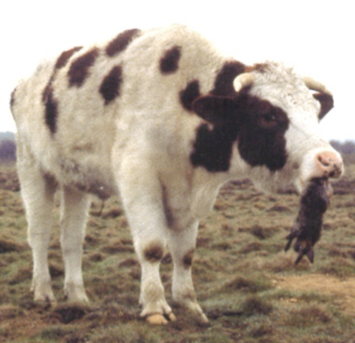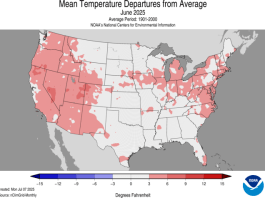
Dr. Harlan Ritchie spent his work life looking at where we started with cattle, where we went, and what we should do next. In Part 1 of this series he looked at the change in cattle body type from the era of large cattle that were work animals first, to animals that were managed for meat production. In Part 2 of this series he shows what happened in the 1900s, which ended in catastrophe in the 50s and 60s. This week he takes us to the end of the 20th Century. Where we go next is up to you.
From 1955 to 1960, cattle size tended to level out and stabilize. During the 1960’s, breeders began to select for increased size, but were not able to make much progress with the bloodlines they were using at the time.
“Ankonian President” was the Grand Champion Angus Bull at the International in 1964. This bull was significantly larger than his contemporaries that were being exhibited at the same time. However, his genotype was not different enough to allow his progeny to differ much from those of other popular sires of the day.
Surplus feed grains and increased demand for grain–fed beef heralded the start of the commercial feedlot industry following World War II. By 1970, the High Plains challenged the Corn Belt as the center of the fed cattle industry. USDA initiated yield grading in 1965. This focused attention on overfat cattle coming out of the nation’s feedyards. The industry began searching for cattle that could be carried to desired slaughter weights without becoming overfat. Charolais–cross steers became popular with feeders and packers
By the early 1960’s, commercial feedyards were not able to feed cattle to an acceptable slaughter weight and Choice grade without getting them overfat, like the yield grade 5 ribeye on the left.
There were too many steers like this one that when fed to a desired fat thickness were too light. Furthermore, their average daily gain was unacceptably low.
Charolais cattle became more numerous and Charolais-sired steers became popular because of their rapid gains in the feedlot and high cutability on the rail.
Within the British breeds, intense selection for leaner, larger–framed, growthier cattle started in the late 1960’s. In 1968-69, a few innovative U.S. breeders found new bloodlines within the British breeds having a propensity for greater lean growth. Western Canada was the initial source of this new genetic material represented here by the Polled Hereford bull, “Predominant 25U,” who became a very important sire. This coincided with the introduction of new breeds from the continent of Europe.
Selection for increased size went unabated from 1969 to 1988. Since 1988, increased emphasis has been placed on carcass traits and structural soundness. All segments of the industry are genuinely concerned about the role of breeds and where they fit into the industry’s needs.
Since 1996, there has been increased emphasis on carcass traits in order to better meet consumer demand. All segments of the industry are genuinely concerned about the role of breeds and where they fit into the industry’s needs.
The American Hereford Association, the American Angus Association, and the American International Charolais Association sponsored type conferences at the University of Wisconsin beginning in 1969 to evaluate the performance of cattle that varied in frame size within their respective breeds.
This eventually led to the development of new U.S. feeder grades (adopted in 1979).
And changes in type standards as shown by this illustration of a 1969 model Hereford female, nursing a calf.
Compared to the 1960 ideal model Hereford female, she represented a needed change.
The 1969 Hereford model steer would still look reasonably acceptable today…
Compared to his 1960 counterpart.
The 1969 International was a pivotal one for the beef industry, when Dr. Don Good of Kansas State University selected “Conoco,” a Charolais-Angus crossbred steer, as Grand Champion of the show – the first crossbred winner of a major show in modern times. He weighed 1250 lbs, quality graded Choice and yield graded 2. He has withstood the test of time and would still be outstanding today.
That same year, Dr. Robert Totusek of Oklahoma State University selected “Great Northern” as the Grand Champion Angus Bull. He was a Canadian bull that was larger, trimmer and heavier-muscled than any Angus bull of his time and helped set the new trend in breeding cattle.
This is the 1971 Denver Grand Champion steer, an excellent Hereford steer that weighed 1250 lb and graded Choice with acceptable cutability.
Here is “Ankonian Dynamo,” Grand Champion, International, 1972. This champion had an outstanding individual performance record and turned out to be a great sire of Angus females.
In the early- to mid-1970’s, there were a number of outstanding champion steers exhibited at the major shows, like this 1270-lb Omaha Ak-Sar-Ben champion that produced a great carcass on the rail. However, size was just starting to get out of control in many steer shows.
One of the largest Champion steers of that era was this 1460-lb Crossbred Champion at the 1973 International. Packers began to raise their voices against excessively heavy carcasses coming from cattle of this size.
Some steers that were exceptional in their cutability were too lean and trim and lacked body capacity.
In 1979, “MSU Miss Magnum,” was the Grand Champion Female at the National Polled Hereford Show. She was the largest heifer anyone had seen in the breed up to then.
By the early 1980’s, some champion show steers were taller than their exhibitors. Here is the 1984 Grand Champion Steer at the Houston Livestock Show…
And the 1985 Champion Angus Steer at the same show.
The trend for Champions in the breeding cattle shows continued to be larger and larger continued. Here is “Coblepond New Yorker.” He weighed 2529 lbs and measured 65 inches tall (5ft 4inches) at 35 months. (Frame 10.0) when he was Denver Champion.
Just like cattlemen couldn’t seem to stop making animals smaller and smaller, now they couldn’t seem to stop heading the other direction either. Here are a few more examples.
This is “Ace Broker,” the Grand Champion Bull at the 1988 National Polled Hereford Show (frame 10).
“Dameron Linedrive” was the Denver Grand Champion Angus Bull. He weighed 2527 just under 3 years old. He was a Frame 10+ bull.
From 1965 to 1989, the average carcass weight of fed steers in the U.S. increased by 15%, from 646 to 742 lb. Because of the normal genetic lag between seedstock and commercial production, it did not peak out until it reached nearly 800 lb in the 1990’s.
What changed? There were a series of significant events that led to a type change in cattle:
January 1986
The National Consumer Retail Beef Study convinced industry that consumers were serious about wanting beef with a higher % of lean and lower % of fat.
April 1987
Excel announced its carcass “specs” for buying cattle for its processing plants, putting more emphasis on muscle thickness. It displayed this 1090-lb slaughter heifer as being near-ideal in her finish and muscle thickness.
At the same time, Excel presented this 1270-lb steer as being near-ideal in his muscle thickness along with enough finish to quality grade low Choice.
May, 1988
The National Beef Conference established recommendations for moderating frame size and increasing muscle thickness.
December 1991
The National beef Quality Audit revealed numerous shortfalls in U.S. beef carcasses.
The chart below shows the effect of muscle thickness on carcass value:
Steer shows began to reflect a change in type to cattle with more muscle thickness and body capacity, like this Ak-Sar-Ben Champion in 1987.
This 1988 Denver champion steer had a hip height of 54.5 inches, weighed 1272 lbs and had an outstanding carcass (0.35 in. fat; 15 sq. in. rib eye, average Choice, and yield grade 1.8).
A Champion pen-of-three carcass steers weighing 1200 lbs and displaying the shape and composition desired in slaughter cattle when Harlen Ritchie completed this historical review. Has something changed since then?
And here’s a rib eye from one of the steers in the previous slide (0.2 in. fat, 15.0 sq. in. rib eye, average Choice, and yield grade 1.6).
Here’s an example of a bull that is extreme in size and frame and lacks muscle thickness and fleshing ability.
Here’s an example of a bull that has adequate frame size and is near-ideal in muscle thickness and fleshing ability. In addition, he appears to be structurally correct.
From 1988 to 1994, frame size went down from 10 to 7, as shown by the Denver Grand Champion Angus Bull, “Big Dry Ranchers’ Choice 1673. He weighed 2530 pounds and had a frame score of 7.3
By 1996, the Denver Champion Angus bull was down to a frame score of 6+. He’s called “Rebar.”
This is the Denver Champion Polled Hereford female in 2001 with a frame score of 6.3.
We could use Wilt Chamberlain and Willie Shoemaker to represent the swings in cattle type that have occurred since the mid-1700’s.
The same genetic variation still exists across our cattle as represented by these two black cattle that went to slaughter the same day at IBP in Iowa. The small female weighed 835 pounds and was extremely fat. The large male weighed 1900 pounds and was very lean.
Dr. Ritchie ended his historical review in 2001. So it’s up to us to put together the story up to today. Where are we going with our cattle size and type? What factors are changing what we do when we think about the perfect animal on our pastures? You can weigh in in the comments below!










































